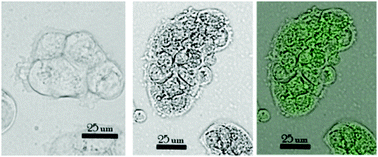Fluorescent squaramide ligands for cellular imaging and their encapsulation in cubosomes†
Abstract
Here, two new fluorescent squaramides bearing quinoline (L1) and naphthalene (L2) as fluorogenic fragments were synthesized and investigated as possible cellular imaging probes. Results showed that L1 is able to pass through the cell membranes of living tumoral (Caco-2) and non-tumoral (293T) human cell lines, while L2 interacts with the cell membranes but does not enter the tested cells. In addition, L1 and L2 were loaded in monoolein-based cubosomes, and also such fluorescent formulations were successfully used for cellular imaging, showing that in vivo application can be conceived for this kind of imaging probes.



 Please wait while we load your content...
Please wait while we load your content...